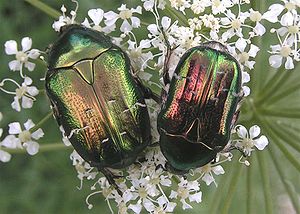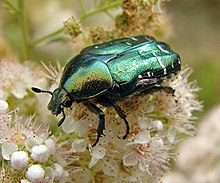Shiny gold rose beetle
| Shiny gold rose beetle | ||||||||||||
|---|---|---|---|---|---|---|---|---|---|---|---|---|

Shiny gold rose beetle ( Cetonia aurata ) |
||||||||||||
| Systematics | ||||||||||||
|
||||||||||||
| Scientific name | ||||||||||||
| Cetonia aurata | ||||||||||||
| ( Linnaeus , 1761) |
The golden rose beetle , also common rose beetle ( Cetonia aurata ), is a beetle from the subfamily of the rose beetles (Cetoniinae). In Germany it is one of the protected species of beetle and was voted Insect of the Year 2000 in Germany.
features
The beetles reach a body length of 14 to 20 millimeters. The top of their body is very variable in color from metallic green to shiny bronze, mostly green, occasionally also gold, blue-green, blue to blue-violet. The underside of the body is red gold. Several white spots and transverse grooves can be seen on the wings . In particular, a striking white transverse band runs between the rear two thirds of the cover wings. Furthermore, there are two broad, flat longitudinal ribs on each wing, which become weaker towards the front and converge at the apical bulge. It happens that the cover wings have a different color from the rest of the upper side. The pronotum is widest just in front of the base and tapers towards the head. The process on the mesosternum ends spherically. Males can be distinguished from females by a shallow longitudinal furrow on the belly side. Like other rose beetles, and in contrast to most other beetle species, the gold-shining rose beetle can unfold its wings in a curve below the elytra and spread out laterally. It then flies with closed elytres, which leads to a characteristic flight pattern.
Occurrence
The animals are found in Europe , north to south of Norway and central Sweden and Finland . The eastern distribution extends over Asia Minor , the Middle East and Siberia to northwest China . The species is only found locally in the British Isles . The shiny gold rose beetle flies from April to October.
protection
The shiny gold rose beetle is a specially protected species under the Federal Nature Conservation Act . According to the Red List of Endangered Animals in Germany, however, it is not considered endangered.
Way of life
The adults are often found on flowers such as roses, fruit trees, elderberries , hawthorns or umbellifers . The larvae ( grubs ) live in rotten wood, in compost and rarely in anthills. Pupation takes place in a cocoon made of soil and wood fibers.
food
The larvae of the rose beetle feed exclusively on rotting plant parts and wooden mulm. The beetles suck up sweet plant juices and eat pollen and other tender flower parts.
Taxonomy and systematics
The Catalog of Life distinguishes between the following subspecies :
- Cetonia aurata aurata
- Cetonia aurata jingkelii
- Cetonia aurata pallida
- Cetonia aurata pisana
- Cetonia aurata pokornyi
- Cetonia aurata sicula
- Cetonia aurata viridiventris
photos
swell
Individual evidence
- ↑ Research for protected species at www.wisia.de
- ↑ BINOT et al .: Red List of Endangered Animals in Germany, 1998
- ^ Catalog of Life
literature
- Karl Wilhelm Harde, Frantisek Severa and Edwin Möhn: The Kosmos Käferführer: The Central European Beetles. Franckh-Kosmos Verlags-GmbH & Co KG, Stuttgart 2000, ISBN 3-440-06959-1 .
- Jiri Zahradnik, Irmgard Jung, Dieter Jung et al .: Beetles of Central and Northwestern Europe. Parey, Berlin 1985, ISBN 3-490-27118-1 .










